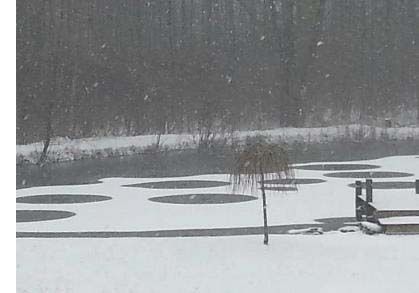Mysterious Pond Circles in NY Spur Talk of Aliens

In the small town of Eden, N.Y., the recent appearance of mysterious circles in a frozen pond has residents baffled.
Last Friday, during an early spring snowstorm, Eden resident Peggy Gervase was looking at the pond near her home when she noticed an unusual pattern in the snow covering the water's surface: large circles that resembled giant polka dots.
"I've never seen this before in our pond," Gervase told local TV station WGRZ. "It's eerie in a way, but cool in a way."
After Gervase posted a photograph of the pond circles to the station's Facebook page, respondents offered a number of explanations for the strange circles, including elephant footprints, fish flatulence and aliens.
Though aliens sometimes get the blame for crop circles and other unusual phenomenon, with no real evidence, Gervase isn't buying it. "I'm not that far gone yet," she told WGRZ.
There are more rational explanations: Natural springs often feed ponds with slightly warmer water than the water freezing at the pond's surface during cold weather. As the warmer spring water rises, it would melt the snow and ice on the pond's surface.
Additionally, decaying vegetation on the bottom of the pond could release gases that slowly rise to the surface, creating the polka-dot effect.
Sign up for the Live Science daily newsletter now
Get the world’s most fascinating discoveries delivered straight to your inbox.
Intriguing circular formations are known to occur throughout the natural world during seasonal freeze and thaw cycles.
In areas of permafrost (like the northern Canadian tundra), the expansion of ice beneath the soil surface — a process called frost heaving — creates raised landforms called lithalsas. Lithalsas often form circular or ring-shaped patterns on the surface.
Frost heaving also creates a related landform called a pingo. Over many years, pingos can grow into small, circular hills: The tallest known pingo is the Kadleroshilik Pingo in Alaska, which reaches 178 feet (54 meters) in height.
Follow Marc Lallanilla on Twitter and Google+. Follow us @livescience, Facebook & Google+. Original article on Live Science.











